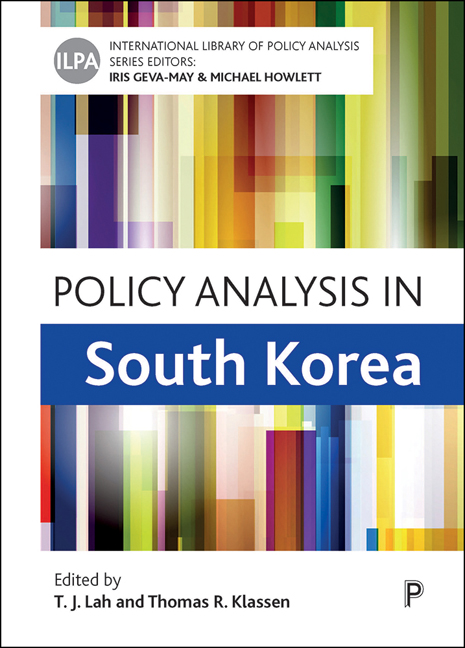Book contents
- Frontmatter
- Dedication
- Contents
- List of figures, tables and boxes
- List of abbreviations
- Notes on contributors
- Acknowledgements
- Editors’ introduction to the series
- Foreword
- Part One Overview of policy analysis in Korea
- Part Two Policy analysis by governments
- Part Three Committees, consultants, media, public inquiries and public opinion
- Part Four Parties, interest groups and advocacy-based policy analysis
- Part Five Academia, research institutes and policy analysis
- Index
two - Policy analytical styles and public institutions in Korea
Published online by Cambridge University Press: 18 January 2024
- Frontmatter
- Dedication
- Contents
- List of figures, tables and boxes
- List of abbreviations
- Notes on contributors
- Acknowledgements
- Editors’ introduction to the series
- Foreword
- Part One Overview of policy analysis in Korea
- Part Two Policy analysis by governments
- Part Three Committees, consultants, media, public inquiries and public opinion
- Part Four Parties, interest groups and advocacy-based policy analysis
- Part Five Academia, research institutes and policy analysis
- Index
Summary
Introduction
Previous studies have reported that different patterns and styles of policy analysis are found in different jurisdictions, policy sectors, and organisational contexts (Kelman et al 2013; Kelman and Hong 2015; Howlett and Lindquist, 2007). Research has also shown that the patterns and styles of policy analysis are important for its successful implementation (Radin, 2000). As Peled (2002: 219) puts it, ‘[i] n practice, ideologically similar administrative reforms differ greatly in style, and style plays an important role in determining their fate’.
Research has also shown that the effectiveness of different styles of policy analysis depends on the governance and administrative contexts in which the analysis is performed (Heineman et al, 2002; Peled, 2002; Christensen et al, 2003; Howlett 2004a). That is, the influence of policy analytical styles is conditioned by contextual elements, including cultural, institutional or other aspects of the policymaking context (Howlett and Lindquist, 2004). Given the importance of the style of an administrative or policy reform, it is critical to understand the uniqueness of policy analytical styles widely adopted in the Korean public administration system.
In this chapter, we describe the policy analytical styles reflected in the performance management of the Korean public institutions, one of the most important policy evaluation systems in Korea. In Korea, the Ministry of Economy and Finance evaluates and analyses the annual performance of public institutions, which are large state-owned enterprises and quasi-governmental organisations. We describe the styles of the evaluation and analyses, explain their positive and negative aspects, and suggest potential theoretical and practical implications.
The remainder of the chapter proceeds as follows. In the next section, we first define the elusive concept of policy analytical styles with a brief summary of the relevant previous works. We then explain the background for the evaluation of the performance of public institutions in Korea. We then proceed the description of the detailed institutional features of the policy analysis system, including its styles, how they changed over time and how they might influence the behaviours of policy actors. Lastly, we conclude the study and discuss our findings.
The concept of policy analytical style
It is important to define clearly the elusive conception of a policy analytical style. The general idea of a policy analytical style is not new, although there has been relatively little research on it.
- Type
- Chapter
- Information
- Policy Analysis in South Korea , pp. 13 - 24Publisher: Bristol University PressPrint publication year: 2023

